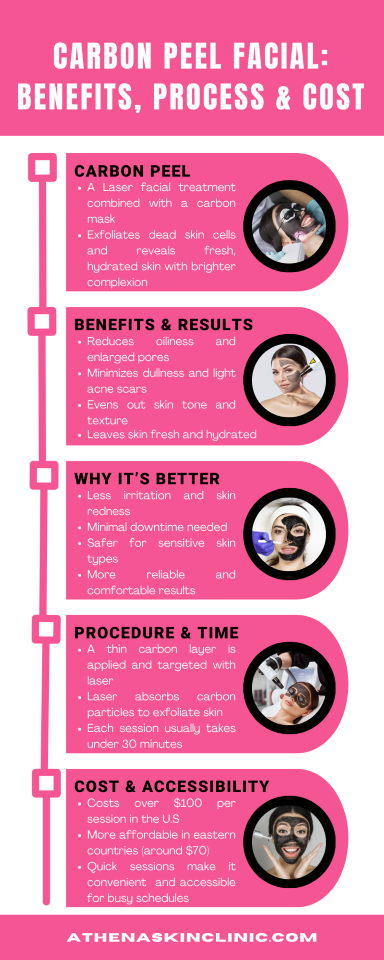Who doesn’t want smooth and radiant skin? We all try to make an effort to achieve a youthful look, which can lead to better confidence and overall happiness.
However, there are some easy ways to get better skin, and carbon peel is one of them. These days, carbon peel treatment has become increasingly popular, with numerous aesthetic clinics and doctors offering it.
There are several gentle resurfacing treatments available, so it is crucial to know what is most suitable and worth the cost.
Each treatment comes with its own price tag, downtime, benefits, and risks. We will discuss how carbon peel fares as a suitable and economical treatment.
What sets the carbon peel apart?
Carbon peel is a favorable treatment because it is non-invasive and does not have too much downtime. Moreover, it is a natural and simpler process than microneedling. In some cases of microneedling, the skin can become irritated and may even fail to give you the results you desired.
Carbon peel is a facial which uses a laser and a carbon mask to remove impurities and reveal fresh and hydrated skin with an even tone and bright complexion.
A thin layer of carbon lotion is targeted with a laser, and the top layer of dead cells and dull skin is exfoliated. The carbon particles absorb the laser energy, effectively exfoliating the skin, so the results are always pleasant. The treatment is quick, and you will see reduced oiliness, dullness, enlarged pores, light acne scars, and uneven tone.
Usually, a session takes under 30 minutes and can be repeated every few weeks, making it accessible and convenient for many.
Book Your Skin Consultation with Dr. Harmandeep Sidhu
Trusted dermatologist in Chandigarh. Get expert care in skin, hair and lasers at Athena Skin Clinic.

Chemical Peels
Another treatment that is similar to a carbon peel is a chemical peel. This treatment uses acids like glycolic, salicylic, or phenol to remove the outermost skin layer, which is mostly dead skin. This peel is the result of exfoliation, and it has the same effects as a carbon peel. You can change the intensity of the chemical peel by regulating the amount of acid you use.
A stronger application of chemicals will reach deeper skin layers to get rid of sun damage, pigmentation, and deeper scars.
However, this treatment requires downtime as it takes longer to heal, and there may be some kind of post and pre-op care that every individual needs.
The cost of this peel can be similar to a carbon peel, but different clinics will charge for the before and after-treatment care. The value of the chemical peel depends on the individual’s skin condition and the intensity of the chemical used.
Microneedling
Microneedling uses fine needles to create controlled micro-injuries, stimulating collagen and improving texture. Alone, it can deliver results over several sessions with minimal downtime, though cheeks may be red for a day or two.
When combined with carbon peel, you get both exfoliation and collagen induction in a single visit, but you’ll pay more for the combined service.
The cost is higher than either treatment alone, but the synergy can make it worth it for concerns like acne scars or uneven texture. The key is ensuring it’s performed by a qualified practitioner using proper technique to avoid complications.
Fractional and ablative lasers
Fractional lasers like fractional CO₂ or erbium can deliver powerful resurfacing by ablating columns of skin with minimal damage to surrounding tissue.
They can dramatically reduce deep wrinkles, deep acne scars, and significant sun damage, but recovery is longer, marketing videos usually show dramatic redness and shedding, and side effects like infection or pigment changes are possible.
Accordingly, these treatments cost significantly more, often hundreds to over a thousand dollars per session, depending on provider and device. If your goals include deep scar remodeling or skin tightening in one or two visits, the cost-per-result might be favorable, but if you want a gentle glow with zero downtime, carbon peel could win by comparison.
Photofacials and light-based therapies
Intense Pulsed Light IPL or photofacial treatments use broad-spectrum light to treat pigmentation, redness, and tone.
They’re effective, particularly on light or moderate pigmentation or vascular issues, and the cost of each session is similar to carbon peels. Downtime is usually minimal. However, carbon peels provide simultaneous exfoliation and pore reduction that IPL doesn’t.
For someone seeking glow and texture improvement, using both modalities in a tailored plan can deliver better results, yet that adds cost and appointments. Value depends on your specific concerns and your tolerance for multiple procedures.
Injectable and Filler Alternatives
Injectables like neurotoxins or dermal fillers can address several issues, like wrinkles or volume loss, not skin surface issues. Pricing varies widely: neurotoxins may cost a few hundred dollars, fillers more.
Comparing cost-effectiveness with carbon peels depends on whether your cosmetic goals revolve around skin quality or structural volume. In many cases, carbon peels serve as a complementary treatment to injectables rather than a substitute.
Side Effects, Recovery Time, and Indirect Costs
Carbon peel wins in the no downtime department; most people resume normal activity immediately with just a bit of redness or mild flaking.
Other treatments, especially deeper peels or ablative lasers, can cost you time, social engagement, and red or peeling skin. Microneedling and IPL fall in between: some redness, little downtime, but occasionally pigment darkening in darker skin types.
Choose wisely because sometimes the cost of skipped work days or stay-indoor recovery outweighs savings on treatment fee.
Tailoring treatments to skin type and goals
Dark or ethnic skin types require extra caution. Carbon peel’s gentleness makes it more forgiving, while deeper peels and burns from aggressive lasers carry higher risk of post-inflammatory hyperpigmentation.
Microneedling may also be safer in such cases, provided techniques and aftercare are attuned. The lowest-downtime gentle approach might be best for maintenance or sensitive tones.
Clinic quality and operator skill impact the value
Whichever treatment you choose, the technician or operator will matter the most, and the cost of the treatment will be worth it if the operator is worth it.
If a dermatologist is doing the carbon peel, and uses good quality materials and a laser, the cost will be higher. Many people go to regular salons only because it charges less.
Similarly, deeper treatments require experienced oversight and knowledge. All these things impact the overall value of the carbon peel. Paying more can be smart if it pays off in consistency, safety, and outcome.
Cost-effectiveness by scenario
Here are some scenarios where you can expect a cut in price for a good carbon peel treatment.
- Quick glow and minimal downtime: Carbon peel often wins the cost-effectiveness award because of the zero-downtime and immediate effects.
- Moderate pigmentation or redness: The superficial chemical peels targeting only the top skin layer may offer similar value if done effectively.
- Sensitive or darker skin: Carbon and microneedling are often the safest, offering reliable benefit with fewer complications.
How to evaluate if treatment is worth it?
When you go for any skin treatment, make sure you know what you want to focus on. Is it the complexion, or scars? If the technician or doctor can deliver what you wanted, the treatment is worth it.
Here are some skin issues to look out for and decide why you want the treatment:
- Is it glow, oil control, or pore size? If yes, then carbon peel is excellent.
- Is it deep scar improvement or dramatic tone change? If yes, you will need some deeper treatments to address the inner skin layers.
- How much downtime can you tolerate?
- How many sessions can your schedule accommodate?
- What’s your budget ceiling, and do you value risk mitigation and comfort?
Compare quotes on equal footing: what’s included, who’s performing it, number of sessions, follow-ups, and aftercare. Sometimes a higher-priced option with more inclusions and better safety nets offers better real-world value.
Final verdict: When carbon peel makes sense
Carbon peel is a great treatment if you want convenient, low-risk, repeatable results, especially if your skin issues are on the surface. It is a budget-friendly treatment to revitalize the skin and is naturally easier on the skin.
This peel is great for maintaining brightness and texture. If deeper results are your goal, be prepared to pay more for stronger methods, but always weigh the trade-offs: recovery time, risk, cumulative cost.
Carbon peel is worth the cost, but it depends on aligning your goals, tolerance for recovery, long-term plans, and the quality of care. Carbon peel is not a cure, but it can correct several skin issues. If you consult the right operator and know the right goals, it can deliver excellent value at a moderate cost.

